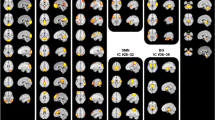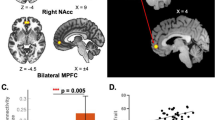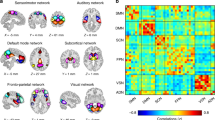Abstract
The mechanism of brain reorganization in pain chronification is unknown. In a longitudinal brain imaging study, subacute back pain (SBP) patients were followed over the course of 1 year. When pain persisted (SBPp, in contrast to recovering SBP and healthy controls), brain gray matter density decreased. Initially greater functional connectivity of nucleus accumbens with prefrontal cortex predicted pain persistence, implying that corticostriatal circuitry is causally involved in the transition from acute to chronic pain.
This is a preview of subscription content, access via your institution
Access options
Subscribe to this journal
Receive 12 print issues and online access
$209.00 per year
only $17.42 per issue
Buy this article
- Purchase on Springer Link
- Instant access to full article PDF
Prices may be subject to local taxes which are calculated during checkout



Similar content being viewed by others
References
Apkarian, A.V., Hashmi, J.A. & Baliki, M.N . Pain 152, S49–S64 (2011).
Chou, R. & Shekelle, P. J. Am. Med. Assoc. 303, 1295–1302 (2010).
Woolf, C.J. & Salter, M.W. Science 288, 1765–1769 (2000).
Baliki, M.N., Schnitzer, T.J., Bauer, W.R. & Apkarian, A.V. PLoS ONE 6, e26010 (2011).
Yarkoni, T., Poldrack, R.A., Nichols, T.E., Van Essen, D.C. & Wager, T.D. Nat. Methods 8, 665–670 (2011).
Baliki, M.N. et al. J. Neurosci. 26, 12165–12173 (2006).
Baliki, M.N., Geha, P.Y., Fields, H.L. & Apkarian, A.V. Neuron 66, 149–160 (2010).
Baliki, M.N., Geha, P.Y. & Apkarian, A.V. J. Neurophysiol. 101, 875–887 (2009).
Isnard, J., Magnin, M., Jung, J., Mauguière, F. & Garcia-Larrea, L. Pain 152, 946–951 (2011).
Seminowicz, D.A. et al. J Neurosci 31, 7540–7550 (2011).
Ungless, M.A., Magill, P.J. & Bolam, J.P. Science 303, 2040–2042 (2004).
Seymour, B. et al. Nature 429, 664–667 (2004).
Zubieta, J.K. et al. J. Neurosci. 25, 7754–7762 (2005).
Johansen, J.P. & Fields, H.L. Nat. Neurosci. 7, 398–403 (2004).
Chanda, M.L. et al. J. Pain 12, 792–800 (2011).
Smith, S.M. & Nichols, T.E. Neuroimage 44, 83–98 (2009).
Baliki, M.N., Geha, P.Y., Apkarian, A.V. & Chialvo, D.R. J. Neurosci. 28, 1398–1403 (2008).
Fox, M.D. et al. Proc. Natl. Acad. Sci. USA 102, 9673–9678 (2005).
Acknowledgements
We thank all of the patients and healthy volunteers that participated in the study. The study was funded by the National Institute of Neurological Disorders and Stroke (NS35115). M.N.B. was funded by an anonymous foundation.
Author information
Authors and Affiliations
Contributions
M.N.B. conducted the experiment, analyzed the data and prepared and wrote the manuscript. B.P. contributed to data collection and analysis. S.T. recruited subjects and conducted the experiment. K.M.H. contributed to data collection. L.H. performed data quality control. T.J.S. recruited subjects and edited the manuscript. H.L.F. wrote the manuscript. A.V.A. designed and supervised the experiment and wrote the manuscript.
Corresponding author
Ethics declarations
Competing interests
The authors declare no competing financial interests.
Supplementary information
Supplementary Text and Figures
Supplementary Figures 1–9 and Supplementary Tables 1–4 (PDF 2122 kb)
Rights and permissions
About this article
Cite this article
Baliki, M., Petre, B., Torbey, S. et al. Corticostriatal functional connectivity predicts transition to chronic back pain. Nat Neurosci 15, 1117–1119 (2012). https://doi.org/10.1038/nn.3153
Received:
Accepted:
Published:
Issue Date:
DOI: https://doi.org/10.1038/nn.3153
This article is cited by
-
CRF regulates pain sensation by enhancement of corticoaccumbal excitatory synaptic transmission
Molecular Psychiatry (2024)
-
Dynamic Changes of the Infralimbic Cortex and Its Regulation of the Prelimbic Cortex in Rats with Chronic Inflammatory Pain
Neuroscience Bulletin (2024)
-
Investigating the brain functional abnormalities underlying pain hypervigilance in chronic neck and shoulder pain: a resting-state fMRI study
Neuroradiology (2024)
-
Increased iron deposition in nucleus accumbens associated with disease progression and chronicity in migraine
BMC Medicine (2023)
-
Temporal pain processing in the primary somatosensory cortex and anterior cingulate cortex
Molecular Brain (2023)



